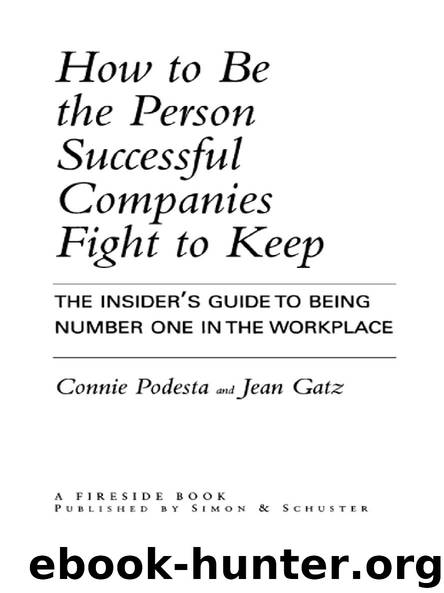How to Be the Person Successful Companies Fight to Keep by Connie Podesta & Jean Gatz

Author:Connie Podesta & Jean Gatz
Language: eng
Format: epub
Publisher: A Fireside Book
Published: 1997-07-15T00:00:00+00:00
FACE-TO-FACE COMMUNICATION
Talking directly to others is probably what most of us think of when we hear the word “communication.” It is impossible for open communication to exist without a commitment from both sides to communicate directly with each other. A climate of trust cannot be developed and maintained in a workplace where gossip, tattling, threats, intimidation, and other forms of manipulation and behind-the-back game-playing are allowed. The problem seems to be that many people do not know how to effectively communicate their concerns, ideas, and feelings face-to-face in a way that will meet their needs, while keeping the relationship strong and healthy.
There are four styles of face-to-face communication: assertive, passive, aggressive, and passive-aggressive. These four styles, each in their own way, affect our ability to communicate openly with others. But assertive communication is the only one of the four that allows us to experience what we like to call “open and trusting” communication. The other three all involve some degree of manipulation, avoidance, or form of game-playing which make it difficult to maintain a relationship built on trust.
Every time we communicate with another person, we can choose one of these four styles in which to frame our thoughts. Open communication can only take place between people who acknowledge that they are responsible for how they communicate. Even though we have become accustomed to using one of these styles more often than the others, we have used all four styles at some point in our lives.
The assertive style is the most effective means of communication, and many visionary companies are offering courses and workshops designed to help their employees communicate more assertively. Although assertive communication is often confused with the aggressive style of communicating, they are actually exact opposites. Assertiveness relies on honesty, openness, forth-rightness, and the commitment not to be a victim or play “the blame game.” When you are communicating with a person who is using the assertive style, there is a strong sense that you are being told the truth in a fair and tactful way.
The human resource director of a large insurance company described an assertive employee:
Claire uses “I” messages which are clear and to the point. She states what she needs without attacking, threatening, bullying, intimidating, or making others feel guilty. She’s a good listener and she respects her team members’ right to voice an opinion, even if it’s different from hers. Claire maintains good eye contact and communicates positive messages through her words and her body language.
The manager of a large dry-cleaning chain also shared an example of one of his best employees, who uses assertive techniques with his customers and co-workers:
Dena cares about people and his professional relationships are based on mutual trust. He is willing to stand up for himself and express his true feelings in an honest, caring way. Even though he is willing to help others, he does not allow others to take advantage of him. He’s been at several of our stores in this region in his twenty-two years with
Download
This site does not store any files on its server. We only index and link to content provided by other sites. Please contact the content providers to delete copyright contents if any and email us, we'll remove relevant links or contents immediately.
| Business School Guides | GMAT |
| Guides | Interviewing |
| Job Hunting | Job Markets & Advice |
| Resumes | Vocational Guidance |
| Volunteer Work |
The Motivation Myth by Jeff Haden(5154)
Audition by Ryu Murakami(4840)
Adulting by Kelly Williams Brown(4484)
The Confidence Code by Katty Kay(4187)
A Mind For Numbers: How to Excel at Math and Science (Even If You Flunked Algebra) by Barbara Oakley(3217)
Waiting in the Wings by Melissa Brayden(3178)
Self-Esteem by Matthew McKay & Patrick Fanning(3091)
Fooled by Randomness: The Hidden Role of Chance in Life and in the Markets by Nassim Nicholas Taleb(3043)
The ONE Thing by Gary Keller(3007)
Nice Girls Don't Get the Corner Office by Lois P. Frankel(2994)
The Dictionary of Body Language by Joe Navarro(2946)
How to be More Interesting by Edward De Bono(2742)
Designing Your Life by Bill Burnett(2667)
Getting Things Done by David Allen(2643)
The Plant Paradox by Dr. Steven R. Gundry M.D(2543)
Police Exams Prep 2018-2019 by Kaplan Test Prep(2482)
What Color Is Your Parachute? 2015 by Richard N. Bolles(2261)
Dangerous Personalities by Joe Navarro(2231)
When to Jump by Mike Lewis(2203)
